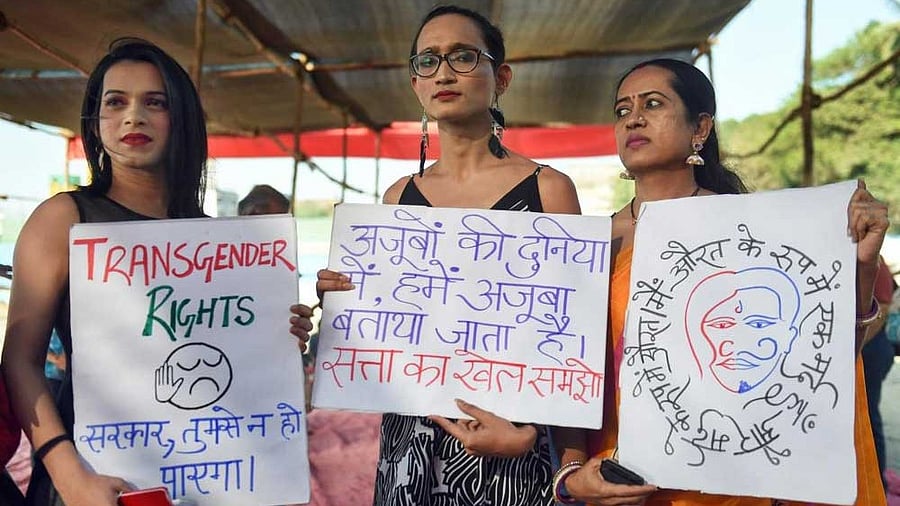
Transgender community members
PTI
In 2014, India witnessed a watershed moment with the pronouncement of the historic National Legal Services Authority (NALSA) judgement which effectively recognised one’s inherent right to gender identity and the right to express one’s chosen identity.
The Supreme Court held that transgender people have the right to identify as male, female or transgender, irrespective of medical sex reassignment. Nearly a decade since the judgment, much has been said and discussed, but very little has been done for the realisation and protection of the transgender community in India. While there is a gamut of issues and problems to address, one of the most fundamental ones that
often slip away from one’s view is the lack of legal protection for transgender people in instances of sexual offences such as rape.
Section 63 of the Bharatiya Nyaya Sanhita, 2023, defines rape as a sexual offence committed by a “man” against a “woman” if he performs a non-consensual act of penetration. The punishment ranges from rigorous imprisonment of not less than 10 years to life imprisonment. Evidently, the law fails to take into account the possibility of rape of a transgender person — trans man or trans woman. The legal coverage under the Transgender (Protection of Rights) Act (2019) is arguably bleak at best, as Section 18(d) of the Act envisages a limited range of abuses, including physical, mental and sexual. It does not explicitly criminalise rape, which differs from sexual abuse in gravity, harm and injury.
The courts have attempted to address the gaps in legal protection for transgender persons in cases of sexual violence. However, the results are not quite satisfactory. In Anamika vs Union of India, the exclusion of transgender persons from Section 354 IPC, which deals with sexual harassment of women, was challenged. The police assured the court that complaints from transgender persons would be registered under this provision in line with the NALSA judgment. However, this assurance does not equate to a legal amendment, leaving transgender persons dependent on police interpretation rather than explicit statutory inclusion.
Another significant case, Ms X vs State of Uttarakhand, involved a trans woman who was raped and blackmailed. She demanded that her complaint be registered under Sections 375 and 376 of the IPC rather than under laws addressing unnatural offences. The court ruled in her favour, affirming that gender identity should be determined by self-identification rather than biological sex. This case set an important precedent for recognising trans women as women under criminal law, reinforcing their right to seek redress for sexual violence under existing rape laws.
However, judicial interpretations are not always progressive. In Bhupesh Thakur vs State of Himachal Pradesh, a transgender woman alleged sexual exploitation under the false promise of marriage. The court observed that Section 69 of the BNS, which criminalises such acts when committed against a “woman”, could not be applied, as the law defines “woman” separately from “transgender persons”. Instead, the accused was charged under Section 18(d) of the Transgender Act, which carries a significantly lighter punishment. This case highlights the legal inconsistencies that continue to limit the protection available to transgender persons in cases of sexual violence.
Such cases showcase progressive judicial attempts to address the issue of criminal protection for transgender people, or its lack thereof. However, there is more to it than meets the eye. The recent NCRB reports from 2020 and 2022 indicate that there was only one case registered under the Transgender Act across India. The statistics are especially surprising, given the frequency and prevalence of sexual offences against the trans community. According to the National AIDS Control Organisation, about 1,000 transgender people out of the 5,000 surveyed had experienced some form of sexual violence in the past year.
Furthermore, about 30% of trans women were found to have been forced into sex during their first sexual encounters, and many of them were minors at the time of the offence. The evident underreporting of cases and systemic and institutional inaccessibility faced by trans people at the hands of the police and the state make their legal protection merely consequential rather than a matter of their rights.
Thus, to ensure adequate recourse and remedy, the law must extend its paternity to so-called peripheral identities. The decision to make gender-neutral rape laws or enact fresh criminal legislation altogether is up to the legislators to debate and decide. While both avenues present a mix of varied possibilities and consequences, the need of the hour is to protect a small yet indispensable part of our population that has historically been subjected to sexual violence and offences.
(Anmol Ratan is a lawyer-cum-researcher based in New Delhi. Priya Chaudhary is a research associate at CLPR, Bengaluru)